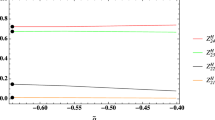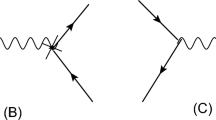Abstract
At the Large Hadron Collider, heavy particles may be produced in pairs close to their kinematic threshold. If these particles have strong enough attractive interactions they may form bound states. Consequently, the bound states may decay through annihilation back into the standard model. Such annihilation decays have the potential to provide much information about the bound particles, such as their mass, spin, or charges, in a manner completely complementary to standard single particle cascade decays. Many of the signatures, such as dijet resonances, will be challenging to find, but may be extremely helpful in unraveling the nature of the new physics. In the standard model, the only novel annihilation decays would be for toponium; these will be hard to see because of the relatively large width of the top quark itself. In models with supersymmetry, marginally visible annihilation decays may occur for example, from bound states of gluinos to dijets or tops. If new particles are bound through forces stronger than QCD, annihilation decays may even be the discovery mode for new physics. This paper presents various theoretical results about bound states and then addresses the practical question of whether any of their annihilation decays can be seen at the LHC.
Similar content being viewed by others
References
J.T. Goldman and H. Haber, Gluinonium: the hydrogen atom of supersymmetry, Physica 15 D (1985) 181 [SPIRES].
W.-Y. Keung and A. Khare, Two-gluino bound states, Phys. Rev. D 29 (1984) 2657 [SPIRES].
J.H. Kuhn and S. Ono, Production and decay of gluino-gluino bound states, Phys. Lett. B 142 (1984) 436 [SPIRES].
E. Chikovani, V. Kartvelishvili, R. Shanidze and G. Shaw, Bound states of two gluinos at the Tevatron and CERN LHC, Phys. Rev. D 53 (1996) 6653 [hep-ph/9602249] [SPIRES].
E. Bouhova-Thacker, V. Kartvelishvili and A. Small, Search for gluino gluino bound states, Nucl. Phys. Proc. Suppl. 133 (2004) 122 [SPIRES].
E. Bouhova-Thacker, V. Kartvelishvili and A. Small, Search for gluino-gluino bound states with ATLAS, Nucl. Phys. Proc. Suppl. 152 (2006) 300 [SPIRES].
K. Cheung and W.-Y. Keung, Split supersymmetry, stable gluino and gluinonium, Phys. Rev. D 71 (2005) 015015 [hep-ph/0408335] [SPIRES].
K. Hagiwara and H. Yokoya, Bound-state effects on gluino-pair production at hadron colliders, JHEP 10 (2009) 049 [arXiv:0909.3204] [SPIRES].
M.R. Kauth, J.H. Kuhn, P. Marquard and M. Steinhauser, Gluinonia: energy levels, production and decay, Nucl. Phys. B 831 (2010) 285 [arXiv:0910.2612] [SPIRES].
B.C. Allanach et al., The Snowmass points and slopes: benchmarks for SUSY searches, Eur. Phys. J. C 25 (2002) 113 [hep-ph/0202233] [SPIRES].
H. Baer, K.-m. Cheung and J.F. Gunion, A heavy gluino as the lightest supersymmetric particle, Phys. Rev. D 59 (1999) 075002 [hep-ph/9806361] [SPIRES].
S. Raby and K. Tobe, The phenomenology of SUSY models with a gluino LSP, Nucl. Phys. B 539 (1999) 3 [hep-ph/9807281] [SPIRES].
N. Arkani-Hamed and S. Dimopoulos, Supersymmetric unification without low energy supersymmetry and signatures for fine-tuning at the LHC, JHEP 06 (2005) 073 [hep-th/0405159] [SPIRES].
V.S. Fadin and V.A. Khoze, Production of a pair of heavy quarks in e + e − annihilation in the threshold region, Sov. J. Nucl. Phys. 48 (1988) 309 [SPIRES].
M. Beneke, A. Signer and V.A. Smirnov, Top quark production near threshold and the top quark mass, Phys. Lett. B 454 (1999) 137 [hep-ph/9903260] [SPIRES].
Y. Kiyo, J.H. Kuhn, S. Moch, M. Steinhauser and P. Uwer, Top-quark pair production near threshold at LHC, Eur. Phys. J. C 60 (2009) 375 [arXiv:0812.0919] [SPIRES].
J.H. Kuhn and P.M. Zerwas, The toponium scenario, Phys. Rept. 167 (1988) 321 [SPIRES].
K. Hagiwara, Y. Sumino and H. Yokoya, Bound-state effects on top quark production at hadron colliders, Phys. Lett. B 666 (2008) 71 [arXiv:0804.1014] [SPIRES].
J.H. Kuhn and E. Mirkes, Toponium production at hadron colliders, Phys. Lett. B 296 (1992) 425 [SPIRES].
J.H. Kuhn and E. Mirkes, QCD corrections to toponium production at hadron colliders, Phys. Rev. D 48 (1993) 179 [hep-ph/9301204] [SPIRES].
N. Fabiano, A. Grau and G. Pancheri, Observability limits for toponium at hadron colliders, Phys. Rev. D 50 (1994) 3173 [SPIRES].
R.M. Barnett, J.F. Gunion and H.E. Haber, Gluino decay patterns and signatures, Phys. Rev. D 37 (1988) 1892 [SPIRES].
M. Toharia and J.D. Wells, Gluino decays with heavier scalar superpartners, JHEP 02 (2006) 015 [hep-ph/0503175] [SPIRES].
W. Kilian, T. Plehn, P. Richardson and E. Schmidt, Split supersymmetry at colliders, Eur. Phys. J. C 39 (2005) 229 [hep-ph/0408088] [SPIRES].
J.L. Hewett, B. Lillie, M. Masip and T.G. Rizzo, Signatures of long-lived gluinos in split supersymmetry, JHEP 09 (2004) 070 [hep-ph/0408248] [SPIRES].
M.E. Peskin and D.V. Schroeder, An introduction to quantum field theory. Westview Press, U.S.A. (1995), section 5.3.
J.H. Kuhn, J. Kaplan and E.G.O. Safiani, Electromagnetic annihilation of e + e − into quarkonium states with even charge conjugation, Nucl. Phys. B 157 (1979) 125 [SPIRES].
V.A. Khoze, A.D. Martin and M.G. Ryskin, Prospects for new physics observations in diffractive processes at the LHC and Tevatron, Eur. Phys. J. C 23 (2002) 311 [hep-ph/0111078] [SPIRES].
P.J. Bussey, T.D. Coughlin, J.R. Forshaw and A.D. Pilkington, Central exclusive production of longlived gluinos at the LHC, JHEP 11 (2006) 027 [hep-ph/0607264] [SPIRES].
G.T. Bodwin, E. Braaten and G.P. Lepage, Rigorous QCD predictions for decays of P wave quarkonia, Phys. Rev. D 46 (1992) 1914 [hep-lat/9205006] [SPIRES].
A. Kulesza and L. Motyka, Soft gluon resummation for the production of gluino-gluino and squark-antisquark pairs at the LHC, Phys. Rev. D 80 (2009) 095004 [arXiv:0905.4749] [SPIRES].
W. Beenakker, R. Hopker, M. Spira and P.M. Zerwas, Squark and gluino production at hadron colliders, Nucl. Phys. B 492 (1997) 51 [hep-ph/9610490] [SPIRES].
A.D. Martin, W.J. Stirling, R.S. Thorne and G. Watt, Parton distributions for the LHC, Eur. Phys. J. C 63 (2009) 189 [arXiv:0901.0002] [SPIRES].
T. Sjöstrand, S. Mrenna and P.Z. Skands, PYTHIA 6.4 physics and manual, JHEP 05 (2006) 026 [hep-ph/0603175] [SPIRES].
T. Sjöstrand, S. Mrenna and P.Z. Skands, A brief introduction to PYTHIA 8.1, Comput. Phys. Commun. 178 (2008) 852 [arXiv:0710.3820] [SPIRES].
G.P. Salam and G. Soyez, A practical seedless infrared-safe cone jet algorithm, JHEP 05 (2007) 086 [arXiv:0704.0292] [SPIRES].
CMS collaboration, Study of the top-pair invariant mass distribution in the semileptonic muon channel at 10TeV, CMS-PAS-TOP-09-009.
CMS collaboration, K. Gumus et al., CMS sensitivity to dijet resonances, CMS-NOTE-2006-070.
G.P. Salam, Towards jetography, arXiv:0906.1833 [SPIRES].
D.E. Kaplan, K. Rehermann, M.D. Schwartz and B. Tweedie, Top tagging: a method for identifying boosted hadronically decaying top quarks, Phys. Rev. Lett. 101 (2008) 142001 [arXiv:0806.0848] [SPIRES].
for the CMS collaboration, G. Giurgiu, Reconstruction of high transverse momentum top quarks at CMS, arXiv:0909.4894 [SPIRES].
J. Thaler and L.-T. Wang, Strategies to identify boosted tops, JHEP 07 (2008) 092 [arXiv:0806.0023] [SPIRES].
L.G. Almeida, S.J. Lee, G. Perez, I. Sung and J. Virzi, Top jets at the LHC, Phys. Rev. D 79 (2009) 074012 [arXiv:0810.0934] [SPIRES].
ATLAS collaboration, Top quark properties, ATL-PHYS-PUB-2009-044.
S.P. Martin, Diphoton decays of stoponium at the Large Hadron Collider, Phys. Rev. D 77 (2008) 075002 [arXiv:0801.0237] [SPIRES].
S. Dawson, E. Eichten and C. Quigg, Search for supersymmetric particles in hadron-hadron collisions, Phys. Rev. D 31 (1985) 1581 [SPIRES].
M.J. Herrero, A. Mendez and T.G. Rizzo, Production of heavy squarkonium at high-energy pp colliders, Phys. Lett. B 200 (1988) 205 [SPIRES].
M. Drees and M.M. Nojiri, A new signal for scalar top bound state production, Phys. Rev. Lett. 72 (1994) 2324 [hep-ph/9310209] [SPIRES].
M. Drees and M.M. Nojiri, Production and decay of scalar stoponium bound states, Phys. Rev. D 49 (1994) 4595 [hep-ph/9312213] [SPIRES].
S.P. Martin and J.E. Younkin, Radiative corrections to stoponium annihilation decays, Phys. Rev. D 80 (2009) 035026 [arXiv:0901.4318] [SPIRES].
J.E. Younkin and S.P. Martin, QCD corrections to stoponium production at hadron colliders, arXiv:0912.4813 [SPIRES].
P. Moxhay and R.W. Robinett, Searching for scalar quarkonium at proton-anti-proton colliders, Phys. Rev. D 32 (1985) 300 [SPIRES].
D.S. Gorbunov and V.A. Ilyin, Stoponium search at photon linear collider, JHEP 11 (2000) 011 [hep-ph/0004092] [SPIRES].
V.D. Barger et al., Superheavy quarkonium production and decays: a new Higgs signal, Phys. Rev. D 35 (1987) 3366 [Erratum ibid. D 38 (1988) 1632] [SPIRES].
E. Arik, O. Cakir, S.A. Cetin and S. Sultansoy, Fourth generation pseudoscalar quarkonium production and observability at hadron colliders, Phys. Rev. D 66 (2002) 116006 [hep-ph/0208169] [SPIRES].
C. Kim and T. Mehen, Color octet scalar bound states at the LHC, Phys. Rev. D 79 (2009) 035011 [arXiv:0812.0307] [SPIRES].
C.D. Carone, J.M. Conroy, M. Sher and I. Turan, Universal extra dimensions and Kaluza Klein bound states, Phys. Rev. D 69 (2004) 074018 [hep-ph/0312055] [SPIRES].
N. Fabiano and O. Panella, Threshold production of meta-stable bound states of Kaluza Klein excitations in universal extra dimensions, arXiv:0804.3917 [SPIRES].
M.J. Strassler and K.M. Zurek, Echoes of a hidden valley at hadron colliders, Phys. Lett. B 651 (2007) 374 [hep-ph/0604261] [SPIRES].
J. Kang and M.A. Luty, Macroscopic strings and ’quirks’ at colliders, JHEP 11 (2009) 065 [arXiv:0805.4642] [SPIRES].
M.J. Strassler and M.E. Peskin, The Heavy top quark threshold: QCD and the Higgs, Phys. Rev. D 43 (1991) 1500 [SPIRES].
V.S. Fadin and V.A. Khoze, Threshold behavior of heavy top production in e + e − collisions, Pis’ma Zh. Eksp. Teor. Fiz. 46 (1987) 417 [JETP Lett. 46 (1987) 525] [SPIRES].
V.S. Fadin, V.A. Khoze and N.G. Uraltsev, Large \(B^0-\bar{B}^0\) mixing and physics of the heavy t-quark, presented at Mtg. on Indirect Evidence of New Energy Scales from Low Energy Precision Experiments, June 22-24, Trieste, (1987), available at http://www-lib.kek.jp/cgi-bin/img index?200033095.
V.S. Fadin, V.A. Khoze and T. Sjöstrand, On the threshold behavior of heavy top production, Z. Phys. C 48 (1990) 613 [SPIRES].
R. Bonciani, S. Catani, M.L. Mangano and P. Nason, NLL resummation of the heavy-quark hadroproduction cross- section, Nucl. Phys. B 529 (1998) 424 [hep-ph/9801375] [SPIRES].
ATLAS collaboration, E. Cogneras and D. Pallin, Generic tt resonance search with the ATLAS detector, ATL-PHYS-PUB-2006-033.
Author information
Authors and Affiliations
Corresponding author
Additional information
ArXiv ePrint: 0912.0526
Rights and permissions
About this article
Cite this article
Kats, Y., Schwartz, M.D. Annihilation decays of bound states at the LHC. J. High Energ. Phys. 2010, 16 (2010). https://doi.org/10.1007/JHEP04(2010)016
Received:
Accepted:
Published:
DOI: https://doi.org/10.1007/JHEP04(2010)016




